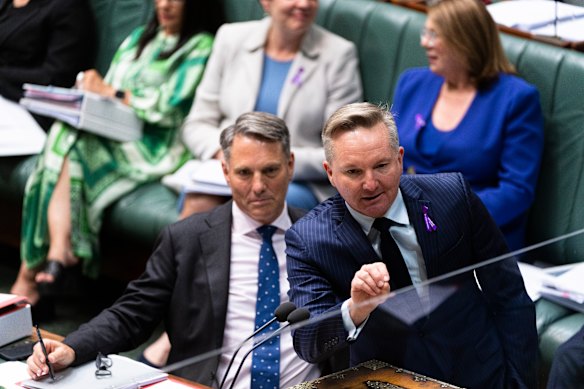Climate Change and Energy Minister Chris Bowen has rejected the Greens key criticism of his signature climate policy, the safeguard mechanism, declaring there is room for new fossil fuel projects without blowing the federal government’s legally binding emissions budget.
Greens leader Adam Bandt is refusing to support the reform unless the government vetoes new coal or gas projects, claiming the increased emissions from fossil fuel projects will blow the safeguard mechanism’s budget. The government will need the Greens’ support in the Senate to pass legislation required to bring the safeguard mechanism into force.
Climate Change and Energy Minister Chris Bowen has ruled out a blanket ban on new fossil fuel projects. Credit:Rhett Wyman
Bowen has ruled out fossil fuel bans, and told this masthead on Wednesday that any new coal or gas project must fit within the total emissions the nation’s big polluters are permitted to generate between now and 2030 under the safeguard mechanism.
The safeguard mechanism’s carbon budget for 2030 sets a cumulative cap of 1233 million tonnes for 215 of the nation’s biggest polluters and any new fossil fuel projects that start. They are required to cut emissions by at least 4.9 per cent a year, or 30 per cent by the end of the decade. This is expected to cut 205 million tonnes of carbon, one-third of the overall reductions needed to achieve Labor’s climate target to reduce greenhouse output by 43 per cent by 2030.
“The proposed scheme settings already account for both new facilities coming online and any expected increase in production from existing facilities and still deliver 205 million tonnes of emissions reductions by 2030,” Bowen said.
The annual emissions cuts required by the safeguard mechanism exceed the volume required to hit the 205 million tonne target, which Bowen said could allow for unforeseen contingencies.
“You can’t put the fire out while pouring petrol on it”: Greens leader Adam Bandt.Credit:Alex Ellinghausen
“The scheme has an additional buffer of 17 million tonnes, which makes sure that even if there was higher than expected production and emissions from existing or new facilities, we can still ensure the scheme delivers the emissions reduction it’s designed to,” he said.
Bandt argues that just one big new gas project would void the emissions reductions achieved under the safeguard mechanism, and warned that the government’s target to cut emissions by 43 per cent by 2030 was not ambitious enough to comply with the Paris Agreement goal of limiting global warming to two degrees.
“The government’s own modellers say that even just a handful of government-backed new projects starting before 2030 will blow the safeguard’s carbon budget by 35 million tonnes of climate pollution,” Bandt said.
“You can’t put the fire out while pouring petrol on it. The best chance of stopping climate collapse and staying within even Labor’s weak targets is by listening to the International Energy Agency, the UN Secretary General and the world’s scientists and not opening any
new coal and gas mines.”
Bandt this week cited modelling by Reputex that found if 16 of the coal and gas projects considered most likely started before 2030, the emissions would exceed the safeguard mechanism budget by 13 to 35 million tonnes by the next decade.
The Reputex analysis aligned with the government’s estimate that the safeguard mechanism would deliver its emissions reduction target if new coal and gas projects that are limited to those that have already reached a final investment decision. These projects include Woodside’s controversial Scarborough gas field in Western Australia, and could generate a cumulative 56 million tonnes of carbon emissions by 2030.
Cut through the noise of federal politics with news, views and expert analysis from Jacqueline Maley. Subscribers can sign up to our weekly Inside Politics newsletter here.
Most Viewed in Politics
From our partners
Source: Read Full Article

